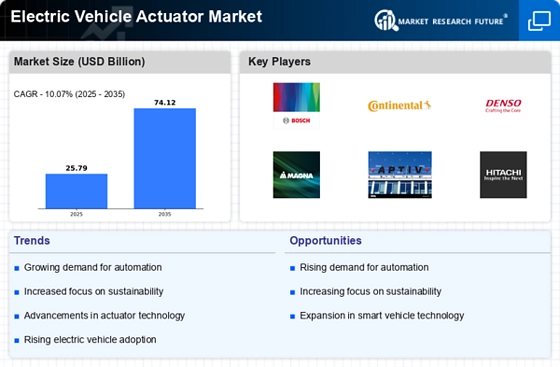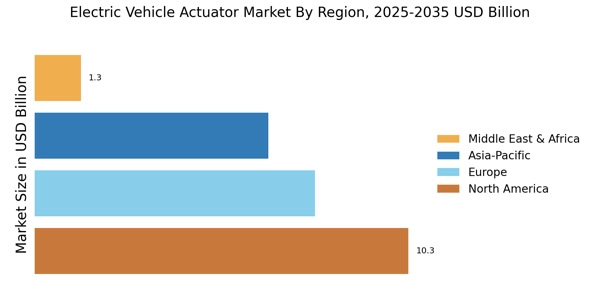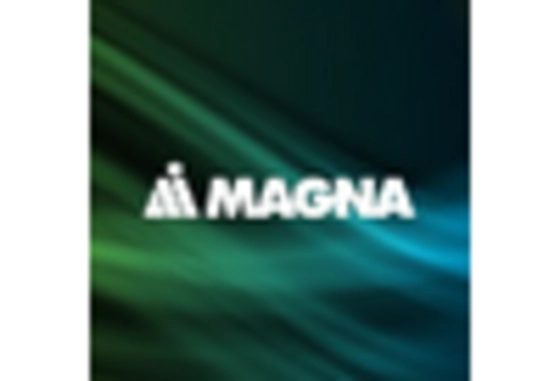Advancements in Actuator Technology
Technological innovations are playing a pivotal role in shaping the Electric Vehicle Actuator Market. Recent advancements in actuator design, such as the development of more efficient and compact electric actuators, are enhancing the overall performance of electric vehicles. These innovations not only improve the responsiveness of vehicle systems but also contribute to energy efficiency, which is a critical factor for electric vehicles. The integration of smart actuators, capable of real-time data processing and adaptive control, is becoming increasingly prevalent. This technological evolution is expected to drive the market forward, as manufacturers strive to incorporate cutting-edge solutions that meet consumer expectations. The Electric Vehicle Actuator Market is thus positioned for growth, as these advancements align with the broader trends of automation and connectivity in the automotive sector.
Rising Demand for Electric Vehicles
The Electric Vehicle Actuator Market is experiencing a surge in demand, driven by the increasing adoption of electric vehicles. As consumers become more environmentally conscious, the shift towards electric mobility is evident. In 2025, it is estimated that electric vehicle sales will account for a substantial percentage of total vehicle sales, leading to a corresponding rise in the need for advanced actuators. These components are crucial for enhancing vehicle performance, efficiency, and safety. The growing consumer preference for electric vehicles is likely to propel the actuator market, as manufacturers seek to integrate innovative technologies that improve vehicle functionality. This trend suggests a robust growth trajectory for the Electric Vehicle Actuator Market, as automakers invest in research and development to meet the evolving demands of the market.
Expansion of Charging Infrastructure
The expansion of electric vehicle charging infrastructure is a critical driver for the Electric Vehicle Actuator Market. As more charging stations are established, the convenience of owning an electric vehicle increases, which in turn boosts consumer confidence in electric mobility. This infrastructure development is likely to lead to a higher adoption rate of electric vehicles, necessitating the integration of advanced actuators for efficient vehicle operation. The Electric Vehicle Actuator Market is expected to see growth as manufacturers respond to the rising demand for electric vehicles, which are increasingly reliant on sophisticated actuator systems for optimal performance. The interplay between charging infrastructure and actuator technology suggests a synergistic relationship that could enhance the overall market landscape.
Government Incentives and Regulations
Government policies and incentives are significantly influencing the Electric Vehicle Actuator Market. Many countries are implementing stringent regulations aimed at reducing carbon emissions, which in turn encourages the adoption of electric vehicles. Financial incentives, such as tax rebates and subsidies for electric vehicle purchases, are further stimulating market growth. As governments push for cleaner transportation solutions, the demand for electric vehicles is expected to rise, consequently increasing the need for efficient actuators. The Electric Vehicle Actuator Market stands to benefit from these regulatory frameworks, as manufacturers align their product offerings with compliance requirements. This dynamic suggests a favorable environment for investment and innovation within the actuator market, as stakeholders seek to capitalize on the opportunities presented by supportive government initiatives.
Growing Focus on Vehicle Safety Features
The emphasis on safety features in electric vehicles is becoming increasingly pronounced, thereby impacting the Electric Vehicle Actuator Market. As consumers prioritize safety, manufacturers are integrating advanced actuator systems that enhance vehicle safety mechanisms, such as automatic braking and stability control. The incorporation of these features not only improves the overall driving experience but also addresses regulatory safety standards. In 2025, it is anticipated that a significant portion of electric vehicles will be equipped with sophisticated safety actuators, reflecting the industry's commitment to consumer protection. This trend indicates a robust demand for innovative actuator solutions that can seamlessly integrate with safety systems, thereby driving growth in the Electric Vehicle Actuator Market.


















Leave a Comment